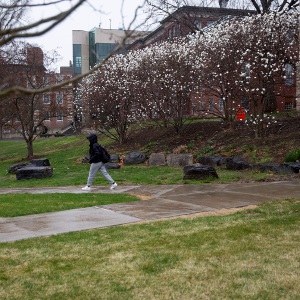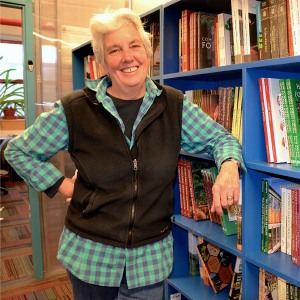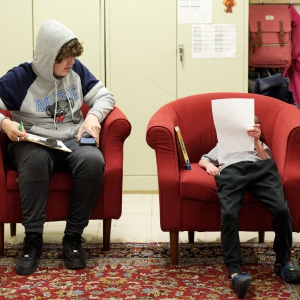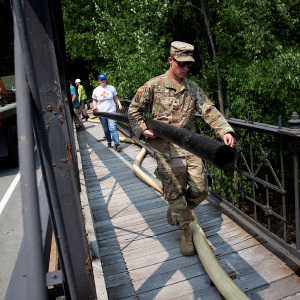As Dartmouth touts sustainable energy efforts, critics say college is moving too slowly
| Published: 09-11-2022 12:26 PM |
HANOVER — Standing at the end of Tuck Drive, between the Tuck Business School and the Thayer School of Engineering, is Dartmouth’s commitment to energy research. In 2015, when the college expressed interest in creating an institute focused on the future of energy use, Canadian oil billionaire Arthur Irving and his family gave $80 million to get the project off the ground.
Last year, Dartmouth hosted a ceremony replete with food trucks, building tours and a light show to honor the grand opening of the $160 million Arthur L. Irving Institute for Energy & Society. Irving’s wife, Sandra, and daughter Sara, a Tuck graduate, sit on the institute’s board.
High-tech features, many of which are invisible — like a system of water pipes under the flooring for heating and cooling and an automated “energy management system” that lets the building more effectively moderate its own temperature and lighting — make the Irving Institute far and away the most efficient building on campus.
“Irving Oil has long been an early adapter of technology and processes that improve the environmental performance of their assets and products,” Dartmouth president Phil Hanlon said in a news release announcing the establishment of the institute. “(The Irving Institute) will be a testament to Arthur Irving’s highest values … and a catalyst for the creation of new knowledge and of future energy leaders.”
But Dartmouth has a long way to go before it can claim leadership status on energy use. With operational impacts of a town almost double the size of Hanover, in addition to using 55,000 megawatts per year from the electric grid, the college annually burns around 3.5 million gallons of No. 6 fuel oil, one of the dirtiest sources of carbon-based power. Dartmouth’s greenhouse gas emissions per student are the highest in the eight-school Ivy League.
Before graduating from Dartmouth in 2021, Jack Firestone researched how the college compares to its peer schools in terms of their energy goals. Despite its chart-topping carbon footprint, Dartmouth is “basically at the bottom of the Ivies in terms of … emissions reduction,” Firestone said.
In the goals that the college currently has on record, Dartmouth has pledged an 80% reduction in greenhouse gas emissions by 2050. Meanwhile, Brown has committed to net-zero emissions by 2040, and Harvard and Yale have committed to net-zero by 2050.
“Dartmouth considers itself a smart second,” Firestone said. “Generally, that’s a great strategy, but smart second right now means you’re in the middle of the pack at best. In this climate crisis, to be a leader you can’t really be a smart second.”
Article continues after...
Yesterday's Most Read Articles
 Zantop daughter: ‘I wish James' family the best and hope that they are able to heal’
Zantop daughter: ‘I wish James' family the best and hope that they are able to heal’
 James Parker granted parole for his role in Dartmouth professors’ stabbing deaths
James Parker granted parole for his role in Dartmouth professors’ stabbing deaths
 2024 Upper Valley high school softball guide
2024 Upper Valley high school softball guide
 Art Notes: After losing primary venues, JAG Productions persists
Art Notes: After losing primary venues, JAG Productions persists
 Chelsea Green to be sold to international publishing behemoth
Chelsea Green to be sold to international publishing behemoth
Statistics from the Intergovernmental Panel on Climate Change, which are guiding the emissions reduction goals of many institutions, say that global emissions must reach net-zero by 2050 to avoid the worst effects of climate change.
At Dartmouth, Firestone was a student of Stephen Doig, senior researcher and strategy adviser at the Irving Institute. Through research with Doig, Firestone learned about the importance of efficiency measures in lowering a school’s energy use.
On a tour of the Irving Institute, Doig was fluent in each of the ways the building is in control of itself. He explained how window shades open and close by themselves at different times of day, and he opened up air ducts to show off a super-efficient ventilation system called the “solar chimney.”
While transitioning to a renewable energy source at Dartmouth is a crucial step in lowering the college’s greenhouse emissions, Doig argues for the importance of “deep energy retrofits,” which among a number of efficiency upgrades, can entail other less flashy efforts, like improving a building’s insulation, installing heartier windows, and upgrading heating and cooling systems.
Doig himself is a veteran retrofitter. In 2010, he led a retrofit of the Empire State Building, which netted the building a 40% reduction in energy use and $4 million in annual savings. Now he’s brought his retrofit gospel to Dartmouth.
Supporting the work for environmental experts like Doig is to the mission of the Irving Institute, which is meant to support the work of “energy specialists from the sciences, social sciences, engineering, business, the humanities, public policy and medicine” the introductory news release said. “The undertaking is a manifestation of Hanlon’s vision to challenge students and faculty to address formidable international problems.”
The efficiency work that Doig specializes in is particularly important on a campus already so dependent on temperature control in its building stock. Dartmouth’s energy demands span all four seasons, as the school has to deal with cold weather, but it also increasingly confronts heat waves. Buildings that are weatherized against extreme temperatures expend less energy to stay comfortable. Plus, energy consumption accounts for three-quarters of the college’s greenhouse emissions, according to “Our Green Future,” the school’s sustainable energy statement.
Having looked at the world from the top of the Empire State Building and then from the ground floor of the highly efficient Irving building that houses his office, Doig said the college hasn’t been acting ambitiously enough in its energy transition.
“The college usually says we don’t have any money to do this,” Doig said. “But we need to convince top management to start out with a beginner’s mind.”
That ethos is what got the retrofit finished at the Empire State Building, and it’s how Doig thinks Dartmouth should approach its own energy efficiency.
“Leadership is about doing things that are hard, not leading from the middle,” Doig said. “And the college leads from the middle.”
But with Dartmouth now in the process of revising their emission reduction goals, and a new president, Sian Beilock, stepping in next July, the college’s green future is still very much in flux.
Calls to leave behind No. 6 fuel oil spurred Dartmouth to consider building a biomass plant, which would have burned wood chips instead of oil. But the idea fell apart in 2019 when a group of alumni involved in climate and energy voiced opposition. A power source that requires deforestation isn’t very renewable in practice, they argued.
John Sterman, a Dartmouth alum and current director of the MIT Sloan School of Management, was one of the most vocal opponents of the biomass plant. He applauded the college for dropping the biomass proposal after spending money and time chasing it.
“It’s quite common that people will just push forward because they’re committed in various ways — financially, psychologically — to what they’ve announced,” he said.
But the reversal, while prudent, left Dartmouth vulnerable again to the problem it had set out to solve.
“OK, they can’t keep burning No. 6 fuel oil in an antiquated plant with inefficient distribution of steam to heat our buildings,” Sterman said. “The question becomes: What are they going to do instead?”
New York City also burned No. 6, until in 2011 it found that 1% of all the city’s buildings — those that burned No. 6 — were responsible for 86% of soot pollution. New York phased out the crude oil within four years.
Dartmouth continues to burn the fuel out of a smokestack right in the middle of Hanover, trucking it into town in 8,000-gallon tanks from the New Hampshire Seacoast, sometimes up to 25 times a week. While it’s no New York City, Dartmouth’s delays in its transition away from No. 6 might be a testament to how complex a system it really is.
When Dev Patel, a current senior at Dartmouth, helped lead the charge in urging the college to divest its stock portfolio from fossil fuels, which the college committed to doing in 2021, he noticed a “mismatch” between Dartmouth’s efforts to position itself as a leader in climate research, and the actual goals the college made for its own climate action.
As Dartmouth showed off its climate and energy research initiatives, like the Irving Institute and the Institute for Arctic Studies, Patel said the college made it clear during the divestment process that while it would try to keep in step with peer institutions, it would never walk out in front.
“It was clear that Dartmouth wouldn’t be a leader on the divestment issue itself,” Patel said. Despite similar agitating from their student bodies, the college didn’t divest until a few months after Harvard did. He sees a similar discrepancy in the way the college is outlining its energy goals.
“The plan by itself is not ambitious enough, especially for an institution of Dartmouth’s scale — both in terms of our technical capacity and the strength of our endowment,” Patel said; the endowment currently clocks in at $8.5 billion.
In Sterman’s work at MIT guiding corporations toward lower-carbon initiatives, the greatest hurdle in ensuring cleaner energy commitments from institutional leaders is the bogeyman of extra costs, he said.
Institutional leaders with the key to the coffers are good at imagining large financial investments related to efficiency improvements and investments in renewable energy sources, but “they’re quite bad at understanding where the capital costs will be lower because of the smaller size of the HVAC system, and the smaller electrical needs,” Sterman said.
The urgency of the energy transition problem is twofold, Sterman said. First, the climate is warming faster than the science said that it would even a few years ago, and the damage of a warming climate — the flooding, the warming, the migration — has struck harder and faster than anyone had expected.
Second, as far as large-scale institutional change goes, universities are particularly prone to “long delays in the system,” Sterman said. Planning for new energy systems and retrofits of existing buildings takes a long time.
The 2050 net-zero aim that many institutions have put in place can suggest a deceptive timeline. “Some people think that we have a fair amount of time to get our act together,” Sterman said. “But that’s just not true. There’s no plausible pathway to net-zero by 2050, or anything like that, if institutions and companies don’t start immediately.”
Execution timeline aside, Dartmouth continues to trail in its goals.
“Eighty percent emissions reduction by 2050 is not ambitious enough at all,” Sterman said, adding that that number falls even below the global targets.
“The privileged institutions within developed economies need to cut even more, and then be the leaders in organizational change to make it happen. That will be good for the college’s reputation. But they’re not there yet.”
The Sustainability Office, housed on the bottom floor of the Irving Institute, is tasked with holding Dartmouth accountable to its energy goals. Rosi Kerr, an alumna who returned to the college after years spent working in community-based energy systems, stands at its helm.
“Working from within the system, she has done a tremendous job slowly chipping away at how the administration and school does things,” Firestone said of Kerr.
As a result of her slow, deliberate chisel, the college has increased its solar capacity significantly, retrofitted a handful of buildings and installed more efficient heating and cooling systems in parts of the campus.
Still, to meet its emission reduction goals, those efforts from the college must continue, and despite resistance to disruptive construction and high price tags, Kerr has to keep the pedal to the metal on piecing together renewable energy sources.
Asking for too much money too fast can turn college officials off from the clean energy project, Kerr said. But if the college were “to keep doing all the same stuff” in an energy system that will soon need to be replaced, it would have to pay annual operating costs in addition to “a ton of capital investment just to keep doing what we’re doing,” Kerr said.
While the timeline to transition requires an urgency not seen in other kinds of capital improvement projects, Kerr also views the challenge as demanding a certain kind of patience and practicality. “Institutions change slowly,” Kerr said. “Still, I think we’ve come a long way, and that change is accelerating.”
The college trustees who she speaks with today are thinking about climate, and prioritizing climate action, in a way that the trustees she spoke with 10 years ago did not, Kerr said.
But if she could alter the decision-making structure at Dartmouth, she would give sustainability a louder voice.
“Harvard has a chief sustainability officer, and lots of our peers have elevated sustainability positions,” Kerr said. “I’m not saying that I want to be in the driver’s seat. What I want is for the president of Dartmouth to be a sustainability advocate, for the head of Thayer to be a sustainability advocate. I want there to be a real sense of how critical this is.”
Kerr views energy transition decisions at the college as the same kind of decisions that have to be made across the globe.
“And because Dartmouth is better resourced than most, we should be able to make these decisions in a way that’s intelligent and manages for our long-term future,” Kerr said. “But they’re not even easy here, and that’s good, from my perspective.”
That constant challenge — voices urging Dartmouth to take its time and examine all the options, to prioritize other initiatives — tempers whatever actions are ultimately taken on sustainability into the best, most enduring decisions, Kerr argued.
She also makes the most of the paradox that comes with the sustainability office being housed in a building named after an oil company.
“From a cynical perspective, and I think about this, it is ironic and inappropriate for the Sustainability Office to be in the Irving Institute,” Kerr said. “But saying that sustainability should have nothing to do with the fossil fuel industry just means that we can’t make enough progress fast enough. This tension is one that we’re all living with in our day to day lives, and it’s false and naive to say that we’re not.”
Even so, clean energy and Irving are strange bedfellows at a school with an already tumultuous energy history, as well as its own energy transition to contend with. Irving Oil has left Arthur Irving with a net worth of $4.4 billion, and the multinational company owns the largest oil refinery in Canada, and it operates more than 900 gas stations across North America — including one in Hanover.
Patel, the Dartmouth senior, has his skepticisms about how effective the partnership is.
“As an institution that’s taking a bunch of money, I’m not so sure if Dartmouth actually exerts any reciprocal pressure on these oil behemoths to actually get them to change their policies,” Patel said, adding that he wonders if Dartmouth is helping Irving “greenwash its way” into continuing fossil fuel operations, using a term for projecting an eco-friendly image.
Kerr encouraged those who think that universities are in the pocket of industries to “keep pushing.” That kind of conflict also keeps the college in check, she said. With these kinds of questions knocking against the Irving building’s triple-pane, insulated windows, Kerr understands the environmental — and reputational — need for the college to step up.
“If you take a really big gift and you’re going to insist that you’re not in the pocket of Irving, you need to demonstrate that,” she said. “Do independent research, and demonstrate that you are willing to say really hard things, like ‘We’re ready to step forward and lead on climate change.’ ”
In the end, Kerr likes her job as energy problem-solver because none of the problems she’s been handed are easy.
“They’re complex,” Kerr said. “And they require empathy. But they also require courage.”
Frances Mize is a Report for America corps member. She can be reached at fmize@vnews.com or 603-727-3242.
]]>

 Some families find freedom with Newport microschool
Some families find freedom with Newport microschool Woodstock Aqueduct Company seeks to double water rates
Woodstock Aqueduct Company seeks to double water rates
